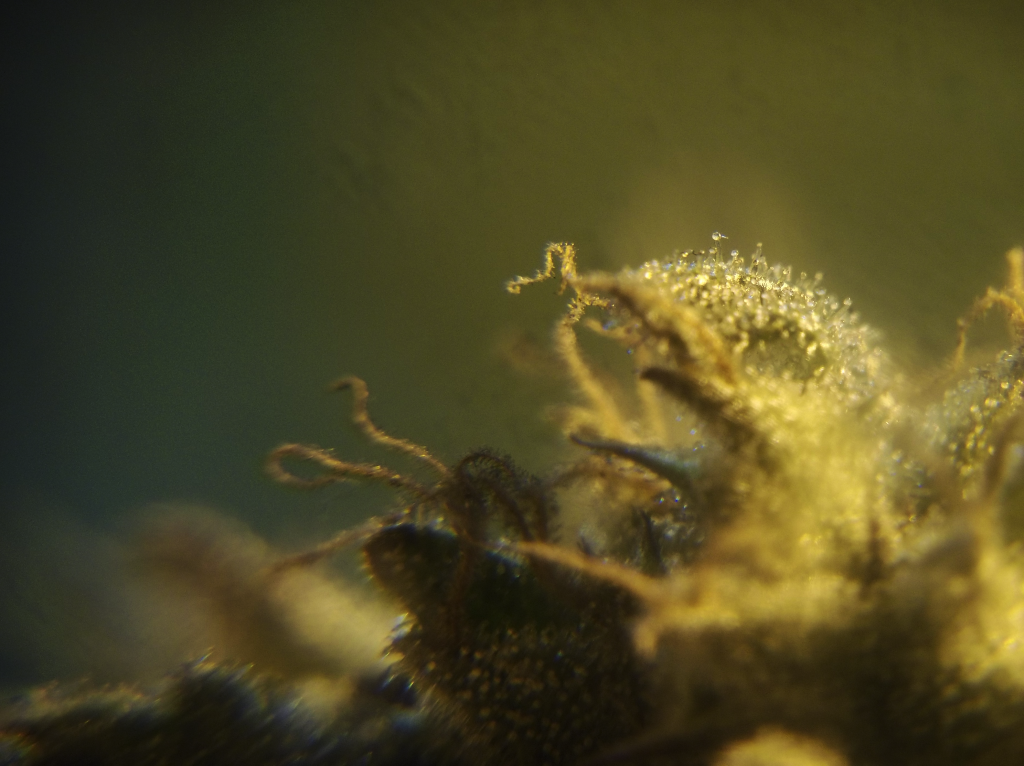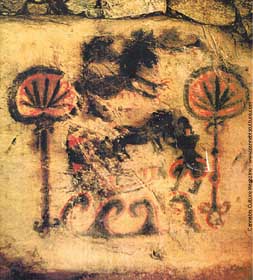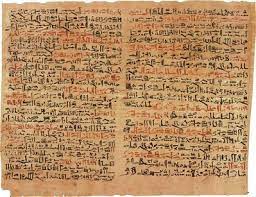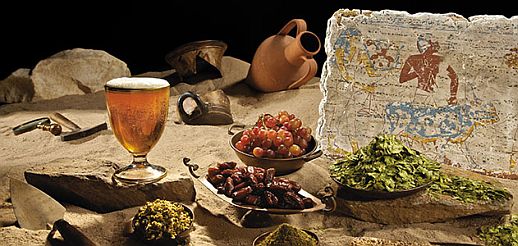Leap through the years with our History of Cannabis Timeline

History of Cannabis- A Timeline
The history of cannabis is complex, long, and steeped with controversy. From it’s origins it has been regarded as a plant with a lot of potential. Historical events are constantly being added to this timeline as we continue to research the history of this wonderful plant and follow it along on its travels.
It all began a long, long time ago...
10,000 BCE - 300 BCE

The earliest traces of cannabis use and cultivation date back to the Jomon Period in Japan. Archeologists have found cave paintings with very apparent cannabis plants, featuring their tall stems and distinguishable leaves.
Ancient Days10,000 BCE - 300 BCE
8000 BCE
First physical evidence of cannabis and hemp use was discovered at an archaeological site in the Oki Islands, dating back to pre-Neolithic Japan
8000 BCE
4000 BCE
Pan-P’o, a neolithic Chinese Village, regards cannabis as one of the essential 5 grains
4000 BCE
3000 BCE
Burned cannabis seeds have also been found in kurgan burial mounds in Siberia dating back to 3,000 B.C.
3000 BCE
2900 BCE
Chinese Emperor Fu Hsi references ‘Ma’ the Chinese word for cannabis as a popular medicine
2900 BCE
2700 BCE
When Chinese Emperor Shen Nung said to have discovered the healing properties of cannabis in legend.
2700 BCE
2737 BCE

Pen Ts’ao Ching, or the Chinese Medica Materia, is written by Shen Nung and references the therapeutic qualities of cannabis. This book is the earliest literature on the medical applications of cannabis.
2737 BCE
2500 BCE
Tombs of noble people buried in Xinjiang region of China and Siberia around 2500 B.C.E have included large quantities of mummified psychoactive marijuana.
2500 BCE
2000 BCE
According to some researchers this marks when Cannabis first came to the Middle East: between 2000 B.C. and 1400 B.C., most likely brought and used there by the Scythians, a nomadic Indo-European group. The Scythians also likely carried the drug into southeast Russia and Ukraine, as they occupied both territories for years. They were widely said to have used cannabis in steam baths. “The Scythians howl in their joy at the vapor bath.” Herodotus 450BCE, The Histories
2000 BCE
2000 - 1000 BCE
Atharva Veda, a Hindu religious text, describes cannabis as the “joy-giver”, “source of happiness”, “bringer-of-joy”.
2000 - 1000 BCE
1550 BCE

The Ebers Papyrus, one of the oldest and most important medical papyri of ancient Egypt, was written about 1550 BCE but is likely copied from older manuscripts dating as far back as 3400 BCE.The Smith Papyrus was written about 1600 BCE but is also based on earlier texts. The Smith and Ebers Papyri present the different medical applications of poppy and cannabis plants recognized in ancient Egypt. Within them Cannabis is recommended as a poultice to deal with inflammation around a toe-nail or finger and as a part of a remedy to cause contractions in the uterus.
1550 BCE
1550 BCE
First written reference in Chinese Pharmacopeia to cannabis
1550 BCE
1450 BCE
Hebrew book of Exodus mentions an anointing oil with a recipe that includes cannabis.
1450 BCE
1213 BCE

Egyptian Tradition includes anointing the corpse with Cannabis pollen. This pollen was found on the mummified remains of King Ramesses II who died in 1213BC.
1213 BCE
1000 BCE

Bhang, a cannabis drink generally mixed with milk, is used as an anesthetic and anti-phlegmatic in India and referenced by 18th-century British adventurer, Thomas Bowrey. Here it is believed it is one of the five sacred plants to bring freedom, happiness, relieve anxiety and woe. Cannabis begins to be used in India to treat a wide variety of human maladies.
1000 BCE
700 BCE
The Venidad, one of the volumes of the Zend-Avesta, an ancient Persian religious text lists cannabis as the most important of 10,000 medicinal plants.
700 BCE
600 BCE

Ayurvedic [a system of Indian medicine] treatise of Sushruta Samhita, otherwise known as the Compendium of Suśruta, is written and refers to cannabis for leprosy. It is also mentioned in the Rigveda and the Atharva Veda positively. The Rigveda, an ancient Indian collection of hymns, mentions a type of elixir for immortality, “soma.” Soma is an intoxicating grassy ritual drink containing cannabis and hemp alongside other holy herbs.
600 BCE
500 BCE
In Pre-Christian Germany people associated marijuana with the Norse goddess of love, Freya.
500 BCE
400-250 BCE
Greek Doctor Claudius Galen notes that cannabis is widely consumed throughout the empire.
400-250 BCE
70 CE
Pedanius Dioscorides, a Greek Physician, writes De Materia Medica citing cannabis as a treatment for earaches and to suppress sexual longing.
70 CE
140 CE
Hempen ropes, for instance, have been found in a well from a Roman fort in Dunbartonshire, Britain, which was occupied between A.D. 140 and 180.
140 CE
207 CE
Hua T’o, the founder of Chinese surgery, is the first recorded physician to use cannabis as an analgesic; using mixtures of cannabis and wine to anesthetize patients prior to surgery.
207 CE
400 CE
Modern scientific studies of pollen in soil samples shows that cannabis was not cultivated in England until around 400 CE when the Anglo-Saxons migrated to the island from their homes in mainland Europe. Since they had no way of knowing if there would be enough cannabis in the lands they conquered to meet their needs, the Romans took hemp ropes with them.
400 CE
800 CE
According to Franz Rosenthal, it was not until late in the ninth century that the use of hashish as an intoxicant surfaced in Islam. Called hashish instead of bhang, the Hindu designation, it was first consumed by members of religious Persian and Iraqi sects located at the eastern periphery of the Islamic empire which bordered the central steppes where the plant had its origins. The plant could be turned into hashish by a couple of methods – the leaves could be baked and turned into a paste, which was then sold in a pill form. Another way was to have the leaves dried, toasted and husked, to which sugar and sesame were added to make a food that could be chewed.
800 CE
820 CE
In 2007, some cannabis seeds were found in a small leather purse among the grave goods of two women buried for more than 11 centuries on a Viking ship. The ship was discovered in 1903 in a mound at the Oseberg Farm near Tønsberg on the west bank of the Oslofjord.The splendid artifacts indicated that the burial had been regal.
820 CE
1025 CE
Avicenna, a Persian Writer, publishes his Avicenna Canon of Medicine- stating cannabis as an effective treatment for gout, edema, infectious wounds, and severe headaches.
1025 CE
1100 CE
Arabic Scholar al-Mayusi regards cannabis as an effective treatment for epilepsy. A sentiment mirrored by co-scholar al-Badri in 1464.
1100 CE
1200s
This is when Some chroniclers believed that cannabis was introduced to the Arab world by the Nizari Ismailis, an Islamic sect, who would go by the name Hashishin, other stories said that Sufi mystics were responsible for introducing it to the masses.By the 13th century Cannabis was being grown throughout Egypt and sold openly in markets where it becomes widely used to treat malaria, and dysentery and spreads inland.
1200s
1500 CE
Spanish Conquistadors bring cannabis to South America where it was used rope and clothing.
1500 CE
1533 CE
After many lost battles in the English Channel, and with a desire for the riches that Egypt had to offer, the kings of England recognized the need for hemp if their realm were ever to compete with Europe. Initially, the monarchs tried to coerce their subjects to raise hemp. The first such fiat came in 1533 when King Henry VIII commanded that for every sixty acres of arable land a farmer owned, a quarter acre was to be sown with hemp. The penalty for not doing so was to be three shillings and four pence.
1533 CE
1563 CE
Thirty years later, and long before the clash with Spain, his daughter Queen Elizabeth I reissued the command, raising the penalty to five shillings.Despite the law, few englishmen complied with the decree. English farmers were also reluctant to substitute hemp seed for grain since they claimed the seed gave an "ill flavor to the flesh of the bird that feeds on it".
1563 CE
1620s
American production of hemp (the cannabis plant) was encouraged by the government to make rope, sails, and clothing. Domestic production of hemp flourished until after the Civil War, when imports replaced hemp.
1620s
1621 CE
The Anatomy of Meloncholy is published by Robert Burton recommending cannabis for depression.
1621 CE
1633 CE
Since ships needed hemp and English farmers refused to supply it, merchants had to go elsewhere for their supplies. Most of the hemp that found its way into English ships during this period came from the Baltic. The best quality hemp came from Danzig, and on several occasions the British government ordered its agents in that city to buy all the hemp they could get their hands on so that England would have enough rope for her ships.[18] Toward the middle of the sixteenth century, growing competition from Russia lured English buyers away from Danzig to the Russian cities of Riga and St. Petersburg. By 1630, Russia was supplying over 90 percent of London's hemp. By 1633, almost 97 percent came from Russia.
1633 CE
1728 CE
Napoleon brings cannabis to France after his pilages in Egypt where it is used for it’s pain assistance and sedative properties.
1728 CE
1762 CE
Virginia puts out a bounty on hemp- imposing penalties on anyone who does not produce it.
1762 CE
1798 CE
William O’Shaughnessy, an Irish Doctor, introduces cannabis to Western Medicine, citing that it had no negative side effects.
1798 CE
1787
Anyone who wanted to consume cannabis in the Middle Ages really had a bad hand. The church dubbed the THC-containing plant as the “devil’s stuff” and banned its consumption. On the island of Madagascar, people were even punished by death in the 18th century if they violated King Andrianampoinimerina’s ban on cannabis.
1787
Early 1800s
Became a popular ingredient in many medicinal products and was sold openly in pharmacies in the United States. While in Egypt Napoleon also had little love for cannabis. As the history of cannabis tells, the French emperor is said to have banned his troops from consuming it altogether in the 19th century. He was afraid that the intoxicating effect of the plant would impair the fighting ability of his soldiers.
Early 1800s
The Venetian Hemp Guild - In Italy, hemp was once called quello delle cento operazioni, "the substance of a hundred operations", because of the many processes to which the plant was subjected before its fibers could be used. During the nineteenth century, Italy became one of the world's main hemp-producing centers, supplying hemp fiber to Switzerland, Germany, England, Portugal, and Spain.
1850 CE
Cannabis first listed in the United States Pharmacopeia, third Ed., as “Extractum Cannabis or Extract of Hemp.”3 The listing continued until 1942
1850 CE
1860 CE
First Federal Commission to Study Cannabis was created
1860 CE
1873 CE
Oxford dictionary references this as the first written use of the word Marijuana in a book by Hubert Howe Bancroft's 1873 The Native Races of the Pacific States of North America. Other early variants include "mariguan" (1894),[12] "marihuma" first recorded in 1905, "marihuano" in 1912, and "marahuana" in 1914
1873 CE
by the late 1890s...
Many members of the medical community considered it a narcotic that should be regulated.
by the late 1890s...
1900 CE
50 years after being listed in the United States Pharmacopeia, and despite a medical community at odds, cannabis remedies were being sold over the counter as remedies for the common cough. More than 100 papers published articles about this, calling it “Pisos Cure” or the “One Day Cough Cure”
1900 CE
1908 CE
Roosevelt appoints Hamilton Wright to be the first Opium Commissioner, directing Narcotic Affairs front he state department of California. Wright pressed to have cannabis included in the initial draft of national narcotics legislation along with cocaine and opiates. This proposal was ill received by the pharmaceutical manufacturers, who objected to the inclusion of a seemingly harmless ingredient of proprietary medicines.
1908 CE
1910 CE
Mexican Revolution- Refugees and Immigrants flood into the United States, bringin with them the “Marijuana Menace”. During the Great Depression, massive unemployment and increased public resentment and fear of Mexican immigrants escalated public and governmental concern about the potential problem of marijuana. By 1931, 29 states had outlawed marijuana.
1910 CE
1911 CE
Massachusettes becomes first state to make cannabis illegal. The push to use marijuana as a tool for racism takes hold. A letter written by Henry J. Finger (father of Californias pharmacy law regulating sales of poison) to Hamilton Wright on July 2, 1911: “Within the last year we in California have been getting a large influx of Hindoos and they have in turn started quite a demand for cannabis indica; they are a very undesirable lot and the habit is growing in California very fast; the fear is now that it is not being confined to the Hindoos alone but that they are initiating our whites into this habit.”
1911 CE
1913 CE
Harrison Act declaring drug- use a crime (opium) in place, does not include cannabis.
1913 CE
1914 CE
Church of LDS bans cannabis usage.
1914 CE
1929-33 CE
Great Depression- Massive unemployment and increased public resentment and fear of Mexican immigrants escalated public and governmental concern about the potential problem of marijuana
1929-33 CE
1930 CE
Federal Bureau of Narcotics is formed by the Department of Treasury to enforce the provisions of the 1914 Harrison Act, appointing Henry Anslinger its first commissioner. Anslinger goes on to be the Father of the War on Drugs and drug policy in our country. Harry Anslinger conflated drug use, race, and music to criminalize non-whiteness.
1930 CE
Early 1930s CE
structure of CBN elucidated
Early 1930s CE
1931 CE
29 states outlawed marijuana by this point. Aslinger begins petitioning against cannabis and using the word “Marijuana” to make it sound more foreign and link it to the immigration issues.
1931 CE
1936 CE
Reefer Madness movie is released, "The political upheaval in Mexico that culminated in the Revolution of 1910 led to a wave of Mexican immigration to states throughout the American Southwest. The prejudices and fears that greeted these peasant immigrants also extended to their traditional means of intoxication: smoking marijuana. Police officers in Texas claimed that marijuana incited violent crimes, aroused a "lust for blood," and gave its users "superhuman strength." Rumors spread that Mexicans were distributing this "killer weed" to unsuspecting American schoolchildren. Sailors and West Indian immigrants brought the practice of smoking marijuana to port cities along the Gulf of Mexico. In New Orleans newspaper articles associated the drug with African-Americans, jazz musicians, prostitutes, and underworld whites. "The Marijuana Menace," as sketched by anti-drug campaigners, was personified by inferior races and social deviants.”
1936 CE
1937 CE
Marijuana Tax Act Passed by Congress- taxing cannabis, this law continues today in policy under the Controlled Substances Act of 1971. In principle, the Marihuana Tax Act of 1937 stopped only the use of the plant as a recreational drug. In practice, though, industrial hemp was caught up in anti-dope legislation, making hemp importation and commercial production in this country less economical
1937 CE
1940 CE
Pharmacological Characteristics Studies with single cannabinoids. Research into Cannabis Begins. First chemical synthesis of CBN occurs and CBD is discovered & Isolated.
1940 CE
1942
THC first extracted from Cannabis. Cannabis is removed from the U.S. pharmacopeia.
1942
1950s CE
Federal laws which set mandatory sentences for drug-related offenses were enacted.
1950s CE
1956 CE
Cannabis included in the Federal Narcotics Control Act
1956 CE
1960 CE
Studies into Cannabis Begin to Increase and there is a Societal Shift- more lenient attitudes towards cannabis
1960 CE
1963 CE
CBD Structures and Stereochemistry elucidated
1963 CE
1964 CE
THC Structures & Stereochemistry elucidated by an Israeli chemist by Raphael Mechoulam. His research marked the beginning of our discovery of the endocannabinoid system and inspired more studies that would later unveil other unknown cannabinoids and sequesterpenes.
1964 CE
1965 CE
CBD & THC are first synthesized in a lab
1965 CE
1970 CE
Studies into Therapeutic Applications begin Controlled Substances Act passed by Congress- Schedule 1 UK Withdraws THC Tinctures as Medicine CBN discover to be natural receptor antagonist Researchers discover that our bodies build up a tolerance to THC over time Congress repealed most of the mandatory penalties for drug-related offenses by this time Over the course of the 1970s, eleven states decriminalized marijuana and most others reduced their penalties.
1970 CE
1971 CE
The Federal Comprehensive Drug Abuse Prevention and Control Act of 1970, more commonly known as the Controlled Substances Act, became effective on May 1, 1971. This act took over the policies of the Marijuana Tax Act of 1937.
1971 CE
1972 CE
President Nixon appoints a council to review marijuana laws. They suggest decriminalizing cannabis and he chooses not to act. John Ehrlichman, counsel to Nixon: “We knew we couldn’t make it illegal to be against the war (Vietnam) or Black, but by getting the public to associate the hippies with marijuana and the Blacks with heroin, and then criminalizing both heavily, we could disrupt those communities. We could arrest their leaders, raid their homes, break up their meetings and vilify them night after night on the evening news. Did we know we were lying about the drugs? Of course we did” (A Tale of Two Countries; ACLU Research Report 2020).
1972 CE
1973 CE
Oregon becomes first state to decriminalize Cannabis
1973 CE
1978 CE
New Mexico becomes the first state to recognize the medical applications of cannabis.
1978 CE
1976-1989 CE
In 1976 a parent's movement against marijuana began and was instrumental in affecting public attitudes which led to the 1980s War on Drugs. Mandatory sentences were re-enacted by President Reagan. The "three strikes you're out" policy, required life sentences for repeat drug offenders. The War on Drugs continued under President George Bush in 1989.
1976-1989 CE
1980 CE
Studies begin on THC and Appetite stimulation
1980 CE
1988 CE
Cannabinoid Receptors CB1 and CB2 Discovered- Humans have an Endocannabinoid system
1988 CE
1990-1993 CE
1990- CB1 & CB2 Receptors confirmed & cloned
1990-1993 CE
1993 CE
Studies into how Receptors work begin Anandamide Discovered- Our Bodies Natural THC- endogenous cannabinoids
1993 CE
1996 CE
California becomes first state to legalize medical cannabis. They passed the “Compassionate Use Act”, or Proposition 215, allowing for the sale and medical use of marijuana for patients with AIDS, cancer, and other serious painful diseases. Tension between federal laws criminalizing marijuana and state laws permitting marijuana in certain circumstances began- this continues today.
1996 CE
1997 CE
Researchers discover that CB1 receptors are found at central & peripheral nerve terminals
1997 CE
1998 CE
Oregon establishes a legal medical marijuana program
1998 CE
2005 CE
Researching Cannabinoids as Analgesics begins
2005 CE
2012 CE
Washington and Colorado are the first states to re-legalize recreational marijuana in the U.S.
2012 CE
2014 CE
In Oregon, Measure 91 was voted in, legalizing the consumption, personal possession, and home growing of cannabis by adults.
2014 CE
2015 CE
Recreational sales begin in Oregon.
2015 CE
2018 CE
The Farm bill was signed into law, removing hemp from the definition of marijuana in the CSA, and declassifying it as a Schedule 1 substance as designated by the DEA.
2018 CE
2022 CE
House passes a Decriminalization of Cannabis bill but it faces an uncertain fate in the Senate.
2022 CE
Sourcing
Alexander Campbell King Law Library, School of Law, University of Georgia Survey of Marijuana Law in the United States, https://libguides.law.uga.edu/c.php?g=522835&p=3575350
Herodotus, The Histories. A. D. Godley, Ed.
http://www.perseus.tufts.edu/hopper/text?doc=Perseus:text:1999.01.0126:book=4:chapter=75
National Library of Medicine, Racism and Its Effect on Cannabis Research, March 2020
https://www.ncbi.nlm.nih.gov/pmc/articles/PMC7173675/
CSA Labs, The Early History of Cannabis and Hemp in Asia, May 20, 2020
https://csalabs.com/the-early-history-of-cannabis-and-hemp-in-asia/
Brittanica ProCon History of Cannabis as Medicine 2900 BC to Present, February 3rd, 2022
https://medicalmarijuana.procon.org/historical-timeline/
DEA Museum, A Life of Service, Henry Jacob Anslinger, Narcotic Enforcement in the 1930s, https://museum.dea.gov/exhibits/online-exhibits/anslinger/narcotics-enforcement-1930s
Anslinger, Henry, Marijuana- Assassin of Youth, The American Magazine, 1938
https://www.druglibrary.org/schaffer/history/e1930/mjassassinrd.htm
US Customs and Border Restrictions, December 20, 2019, Did you know…Cannabis was once a legal cross-border import” https://www.cbp.gov/about/history/did-you-know/marijuana#:~:text=In%20principle%2C%20the%20Marihuana%20Tax,in%20this%20country%20less%20economical.
American Civil Liberties Union, A Tale of Two Countries: Racially Targeted Arrests in the Era of Marijuana Reform, 2020
https://www.aclu.org/report/tale-two-countries-racially-targeted-arrests-era-marijuana-reform
Dale H. Gieringer, The Origins of Cannabis Prohibition in California, 1999.
https://www.canorml.org/wp-content/uploads/2019/04/caloriginsmjproh.pdf
NPR, The Mysterious History of Marijuana, Matt Thompson, July 22, 2013,
https://www.npr.org/sections/codeswitch/2013/07/14/201981025/the-mysterious-history-of-marijuana


Recent Comments